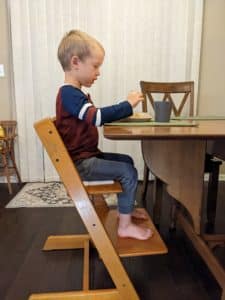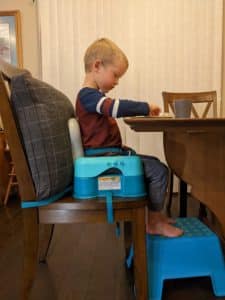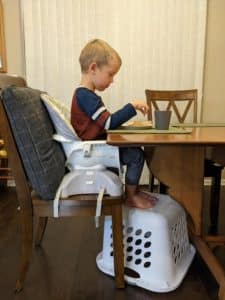The Importance of Positioning – How to get your child into the right position at the table
There are several reasons why a child may be having a hard time staying at the table during meals. But, most of the time, they won’t (or can’t) sit still because they do not have adequate postural stability.
What do we mean by postural stability?
Postural stability involves many different demands that are required by your body. Your body must have enough motor control to stabilize yourself in the environment. That means it must have enough control to go about whatever motor plan you are doing (i.e., walking down a hallway, sitting in a chair, etc.). Postural stability also uses sensory inputs to tell you where your body is in space. These senses include your vision, touch, proprioception (input into your muscles and joints), and your vestibular system (i.e., telling you information about motion, head position, balance, and spatial orientation). You have to be able to integrate these sensory systems with the action of the muscles. While you are doing all of this, you have to be able to keep the body’s center of mass within its base of support. It is a lot! If we are stable, we don’t have to worry as much about all of these other factors. However, if there are any difficulties with stability, you can see how hard it may be to also try to focus on something new or tricky, like eating or schoolwork.
Why is Postural Stability so important?
Postural Stability is actually our bodies’ second priority (breathing is first, eating is the third priority). One reason is it helps protect our brains. Postural stability ideally keeps us upright and prevents us from falling on our heads. Your body focuses on how to keep your head safe! So, when we are stable, it frees up the motor brainpower to sit and focus on whatever the task is (i.e., eating or homework; rather than not falling on your head).
Another reason why postural stability is so important is that it supports respiratory function. When our torso is upright, it gives us the best posture to allow for our organs and tissues to achieve full respiratory capacity. It is so much easier for oxygen to reach your body when you are positioned well.
Additionally, when we have postural stability, it provides security within your seating arrangement. It allows for better hand-to-mouth coordination (i.e., bring up your spoon to your mouth to feed yourself or bring an open cup to your mouth and resting it against your lower lip as your coordinate tilting the cup to drink). Postural stability also supports the fine motor and tactile manipulation of the food (using utensils to eat neatly) or a pencil (using neat handwriting when doing schoolwork).
Postural stability also allows for better oral-motor movements while eating. This includes things like a better range of motion in the jaw for chewing and more precise tongue movements when moving food around your mouth.
The barstool and adult chair, below, do not provide sufficient postural stability for this child.
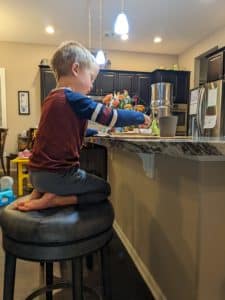

How do you know your child may have difficulties with postural stability?
Here are some things you want to look for:
- Slouching while sitting or sliding out of their chair
- Using a hand to prop themselves up when sitting (maybe by putting a hand on the side of the chair, or holding their head up with their hand with their elbow on the table)
- Joint locking/fixing (extending your joints, so you don’t have to use a lot of muscular effort). This makes kids look stiff.
- Preferring to stand or walk around while eating
- Being in constant motion while in their chair
- Frequently getting down from their chair during meals
How can we help our kids achieve greater postural stability?
There are several things we can do to adjust the chair your child is already sitting in to help improve their postural stability. We recommend adjusting their chair so that there are 90-degree angles at your child’s hips, knees, and ankles. Lets look at how to do this.
- First, we need to get the child up to the right height at the table. We ideally want the tray/table surface should fall between your child’s belly button and breast level. A booster seat can help get a child tall enough in their chair at the table or you may experiment with a firm cushion or a stack of books. It is recommended that you secure whatever you choose for your child to sit on to the chair so it doesn’t move around.
- Your child should be forward enough that their knees can bend over the front of the chair at a 90 degree angle, while they can still lean against the backrest of the chair. You may need to find a firm pillow or another object to put behind your child’s back to make a backrest. If your child is in a booster seat, the booster will likely need to be brought to the front of the chair instead of being strapped to the back of the chair.
- Your child also needs a footrest. A footrest better supports your body posture and significantly increases your stability in the chair. You might already have a small step stool that is the right height, or you may have a diaper box, plastic bin, or laundry basket that is the right height.
Here are some examples of how this might look.
You may also consider adding the following to your child’s chair for a little extra support:
A No-Skid Mat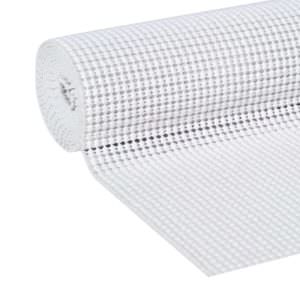
Buy a roll of shelf liner and cut a piece about the size of your child’s chair. A no-skid surface will help the chair not be so slippery. The awesome thing about these is that you can easily roll them up and throw them in the diaper bag or your purse so that you can have them in restaurants, at grandma’s house, and day care. The kind with the bumps on it works the best. (It also can go through the dishwasher!) You can look for shelf liner on Amazon, or at Target, Walmart, and many other stores.
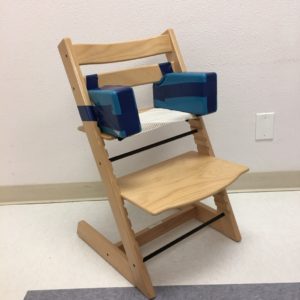 Side Supports
Side Supports
Depending on the type of chair your child is sitting in, how we add side supports will vary. For example, if your child is sitting in a chair that already has sides but is too wide, you can fold a towel and slide it behind their back, then roll the sides up to fill in the space between their body and the sides of the chair. You may also be able to fill in the space with a box or yoga block. I prefer to use a yoga block, as they are easy to cut to size and wipe down. In a pinch, you can also upcycle food boxes that are the right size and cover them in duct tape so you can clean them.
Take a few minutes, and make some changes to your child’s chair. You will hopefully see quite an improvement! We hope these strategies help you think about your child’s chair for meals and other activities that happen at the table (like homework!). For recommendations for a chair that will grow with your child, check our Chair Recommendations by Age article.
 ☰ Menu
☰ Menu

